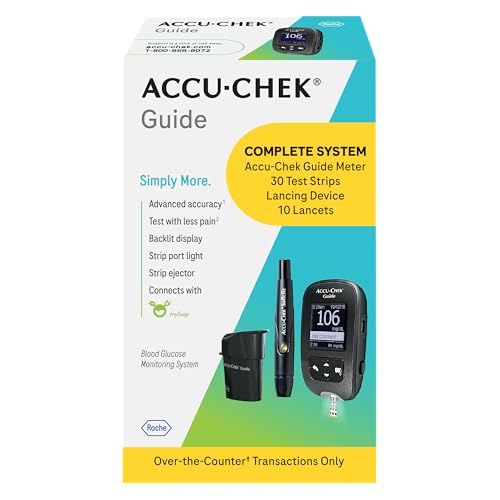For cat owners, having a diabetic feline can be a stressful and worrisome situation. One of the most important tools for managing your cat’s diabetes is a reliable glucose meter, allowing you to monitor your cat’s blood sugar levels. But with so many options out there, it can be overwhelming to choose the right one. Not to worry, we’ve got you covered! In this article, we provide you with everything you need to know about choosing the best glucose meter for your diabetic cat. Keep reading to learn more.

Understanding your Cat’s Diabetes
Understanding your cat’s diabetes is crucial to choosing the right glucose monitoring device. Diabetes is a common ailment in cats, especially in the middle-aged and older felines. It occurs when a cat’s pancreas cannot produce enough insulin to regulate blood sugar, resulting in high levels of glucose in the bloodstream.
Symptoms of cat diabetes include increased thirst and urination, weight loss, fatigue, and a poor coat appearance. If you notice any of these signs, it is essential to take your cat to the vet for a thorough examination. If your cat is diagnosed with diabetes, your vet will recommend changes in diet and lifestyle, as well as prescribe insulin therapy.
Why is a glucose meter important?
A glucose meter is a device that allows owners of diabetic cats to monitor their pets’ blood glucose levels at home. Regular monitoring is crucial to preventing hypoglycemia (low blood sugar) and hyperglycemia (high blood sugar). Uncontrolled diabetes can lead to life-threatening complications, including seizures, liver and kidney damage, nerve damage, and blindness. By monitoring your cat’s blood sugar levels, you can adjust insulin dosages and maintain optimal glucose levels for your pet’s health and well-being.
Types of glucose meters available for cats
There are different types of glucose monitoring devices available for cats, including handheld meters with test strips, continuous glucose monitoring (CGM) systems, and non-invasive devices. Handheld meters with test strips are the most commonly used in-home glucose monitoring devices. They require a small blood sample, usually obtained from the cat’s ear or paw pad, and display the results within a few seconds.
Continuous glucose monitoring systems are recommended for cats that require frequent blood glucose monitoring. They use a device called a sensor that is attached to the cat’s skin to measure glucose levels continuously. The device sends real-time data to a smartphone app, allowing owners to track their cat’s glucose levels throughout the day.
Non-invasive glucose monitors use laser technology to measure blood glucose levels through the cat’s skin. They are less invasive than handheld meters and continuous glucose monitoring systems, but they are not as accurate.
Factors to consider when choosing a glucose meter
When choosing a glucose meter for your cat, several factors should be considered. These include:
Accuracy: The accuracy of the glucose meter is crucial to maintaining optimal glucose levels in diabetic cats. Ensure that the device you choose is accurate and reliable.
Ease of use: The device should be easy to use, with clear instructions on how to obtain blood samples and read the glucose levels.
Cost: Glucose meters vary in cost, ranging from a few dollars to a few hundred dollars. Choose a device that is within your budget but offers the features and accuracy you need.
Size/portability: If you plan to monitor your cat’s glucose levels while on the go, consider a small, portable device that you can carry in your bag or pocket.
Support: Choose a device with good customer support and after-sales service options.
How to properly use a glucose meter on your cat
Using a glucose meter on your cat requires practice and patience. It is recommended to work with your vet to learn how to obtain blood samples and read the results accurately. Always follow the device’s instructions carefully and be gentle when handling your cat’s paws or ears.
Our top picks for the best glucose meters for cats
AlphaTRAK 2 Blood Glucose Monitoring System: This meter is accurate, reliable, and easy to use, making it a top pick for diabetic cat owners.
PetTest Blood Glucose Monitoring System: This meter is affordable and comes with a lifetime warranty, making it an excellent choice for budget-conscious owners.
FreeStyle Lite Blood Glucose Monitoring System: This meter is compact and easy to use, making it a great option for owners who need to monitor their cat’s glucose levels while on the go.
OneTouch Ultra 2 Blood Glucose Monitoring System: This meter is user-friendly and comes with a large, easy-to-read screen that displays the results clearly.
Contour Next EZ Blood Glucose Monitoring System: This meter is easy to use and accurate, making it a popular choice among diabetic cat owners.
In conclusion, choosing the right glucose meter for your cat is essential for managing diabetes effectively. Consider the accuracy, ease of use, cost, portability, and customer support when selecting a device. With proper monitoring, your cat can lead a happy and healthy life with diabetes.
Why is a Glucose Meter important?
Monitoring blood glucose levels is critical for cats with diabetes. Because of their illness, they need constant monitoring of their glucose levels to ensure they stay within healthy ranges and avoid complications. Without a glucose meter, it can be impossible to know when a cat’s glucose levels are too high or too low, leaving them at risk for complications such as ketoacidosis.
A glucose meter is a device that measures blood glucose levels in cats. It allows you to test your cat’s glucose levels quickly and easily, and to monitor those levels on an ongoing basis. With regular monitoring, you can adjust their insulin doses, diet, and exercise as needed to keep their glucose levels within a healthy range. This can help prevent complications and improve your cat’s quality of life.
When choosing a glucose meter for your cat, it is important to choose one that is reliable and accurate. Look for a glucose meter that you find easy to use and that is comfortable for your cat. Some cats may not like being pricked for blood, so you may want to choose a glucose meter that requires a smaller blood sample or has a less painful lancet.
There are many different types of glucose meters available for cats, ranging from simple handheld models to more advanced digital models. Some are designed specifically for pets, while others are designed for humans but can be adapted for use with cats. When choosing a glucose meter, it is important to consider your cat’s needs and your own preferences.
In the next section, we will cover the different types of glucose meters available for cats and provide a detailed guide on how to properly use a glucose meter on your diabetic cat.
Types of Glucose Meters available for Cats
For cat owners, choosing the right glucose meter for their diabetic feline is crucial in managing their condition. With so many options available in the market, it can be overwhelming to decide which one to get. In this section, we will discuss the different types of glucose meters available for cats.
Blood Glucose Monitoring Systems
Blood glucose monitoring systems are the most common type of glucose meters available for cats. This type of meter requires the cat’s blood to be drawn through a prick on the ear or paw pad, and the blood sample is placed on a test strip attached to the meter. The meter then displays the cat’s blood glucose level. Most blood glucose monitoring systems have a memory function that stores past glucose readings, making it easier for owners to track their cat’s progress.Non-Invasive Glucose Monitoring Systems
For some cat owners, the idea of pricking their feline’s skin to obtain a blood sample may be intimidating or too distressing for their pet. This is where non-invasive glucose monitoring systems come in. These meters use a sensor to measure the cat’s glucose level without the need for a blood sample. Instead, the sensor reads the glucose level on the cat’s skin. Non-invasive glucose meters are typically more expensive than traditional blood glucose meters, but they offer a pain-free alternative for diabetic cats.Handheld Glucose Meters
Handheld glucose meters are typically small and portable, making them perfect for cat owners who travel frequently with their pets. These meters require a blood sample, which is obtained through a prick on the ear or paw pad, and the sample is placed on a test strip attached to the meter. Handheld glucose meters are reliable and accurate, making them a popular choice for cat owners who need to monitor their pet’s glucose levels on the go.Veterinary Glucose Meters
Veterinary glucose meters are usually more expensive than other types of glucose meters, but they are specifically designed for use on animals. These meters are designed to be more durable and can withstand rough handling, making them ideal for use in veterinary clinics or animal hospitals. Veterinary glucose meters require a blood sample, and the sample is placed on a test strip attached to the meter.
When choosing a glucose meter for your cat, it’s essential to consider your pet’s needs, as well as your lifestyle. Some meters may be more expensive than others, but they may offer features that can help you better manage your cat’s condition. In the next section, we’ll discuss the factors that you should consider when choosing a glucose meter for your diabetic cat.
Factors to Consider when Choosing a Glucose Meter
When it comes to choosing the right glucose meter for your diabetic cat, there are several factors to consider. Here are some things to keep in mind when making your selection:
Accuracy: The most important factor to consider when choosing a glucose meter for your cat is accuracy. You want a meter that provides reliable and consistent readings so you can effectively monitor your cat’s blood sugar levels.
Convenience: Another important factor is convenience. You want a meter that is easy to use and requires minimal preparation and setup. This is particularly important if you need to test your cat’s blood sugar frequently.
Cost: Cost is also a consideration, as glucose meters can range in price from very inexpensive to quite expensive. However, keep in mind that accuracy and convenience are more important factors than cost when it comes to choosing a glucose meter for your cat.
Type of Monitoring: Different glucose meters use different methods to measure blood sugar levels. Some require a blood sample from a prick on the ear or paw, while others are non-invasive and rely on sensors that attach to the skin. Consider which type of monitoring is best for your cat based on their temperament and your preferences.
Size: The size of the glucose meter is another consideration. Some meters are small and portable, making them easier to carry around with you. Others are larger and may require more storage space.
Compatibility: Consider whether the glucose meter is compatible with any apps or software programs that you use to track your cat’s diabetes management. Some meters can sync with smartphone apps to provide detailed data and analysis.
By considering these factors, you can choose a glucose meter that meets your cat’s needs and helps you effectively manage their diabetes.
How to Properly Use a Glucose Meter on your Cat
Properly using a glucose meter on your cat can be challenging, but it is crucial for monitoring their health. Here are some steps to ensure that you are using a glucose meter correctly:
Prepare the test site: Before testing your cat’s blood glucose level, prepare a clean and dry site for the test. You can do this by wiping the area with alcohol or soap and water.
Get a blood sample: Obtain a blood sample by pricking your cat’s ear, lip, or paw with a lancet. Be sure to only prick the outer layer of skin to minimize any pain to your cat.
Apply blood to test strip: Squeeze a drop of blood onto the test strip and wait for the results to appear on the meter.
Read the results: The glucose meter will give you a reading for your cat’s blood glucose levels. Record the results and seek veterinary advice if any concerns arise.
Dispose of lancet and strip properly: Dispose of the lancet and test strip properly and wash your hands before handling your cat to prevent infection.
It is essential to practice proper hygiene and safety measures when using a glucose meter on your cat. Always consult your veterinarian before making any changes to your cat’s medication or diet based on glucose meter readings. By following these steps, you can ensure accurate and reliable results from your glucose meter while keeping your cat healthy and happy.
Our Top Picks for the Best Glucose Meters for Cats
After careful research and consideration, we have compiled a list of the best glucose meters for cats. These meters have consistently proven to be reliable and accurate, while also being user-friendly and affordable. Here are our top picks:
- AlphaTRAK 2 Blood Glucose Monitoring System
The AlphaTRAK 2 Blood Glucose Monitoring System is one of the most popular glucose meters for cats on the market. It is specifically designed to provide accurate readings for felines, with a range of 20 to 750 mg/dL. It also has a user-friendly interface and requires only a tiny amount of blood for testing. This meter comes with a sleek and compact design, and it is easy to use for both pet parents and veterinarians.
- PetTest Blood Glucose Meter Kit
The PetTest Blood Glucose Meter Kit is another reliable option for diabetic cat owners. It features an easy-to-read display, with results available in just seconds. The kit also comes with a lancing device, test strips, and a carrying case, making it a complete package for at-home use. Pet parents love how affordable this meter is, while still providing high-quality readings for their furry friend.
- iPet Glucose Monitoring Kit
The iPet Glucose Monitoring Kit is the perfect option for pet parents who are always on the go with their diabetic cat. This meter is incredibly portable, with a compact and lightweight design. It can be easily slipped into a purse or bag for on-the-go testing. It also features a high-contrast display, making it easy to read in any lighting. This kit has an affordable price point and comes with test strips, lancing device, and carrying case.
- Contour NEXT EZ Diabetes Testing Kit
The Contour NEXT EZ Diabetes Testing Kit may not be specifically designed for cats, but it still proves to be a reliable option for feline glucose monitoring. The kit is easy to use and provides accurate results in just five seconds. The kit also comes with test strips, lancing device, and carrying case, making it a complete package for pet parents. This meter is often used in veterinary clinics and hospitals, so it is a popular choice for cat owners who want professional-level readings at home.
- OneTouch Ultra 2 Blood Glucose Monitoring System
The OneTouch Ultra 2 Blood Glucose Monitoring System is a popular choice for diabetic cat owners who are looking for advanced features. This meter provides accurate readings and has a range of 20 to 600 mg/dL. It also has an easy-to-read display and a sleek design. It comes with test strips, lancing device, and carrying case. Pet parents appreciate the advanced features such as before and after meal markers, and the ability to download readings onto a computer for further analysis.
Choosing the right glucose meter for your diabetic cat is essential for their health and well-being. These top picks provide reliable and accurate readings, while also being user-friendly and affordable. We encourage you to do your research and consult with your veterinarian to find the best option for your furry friend.

















